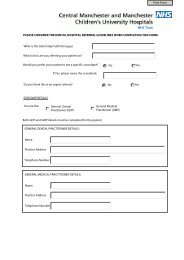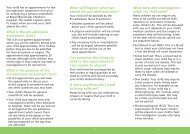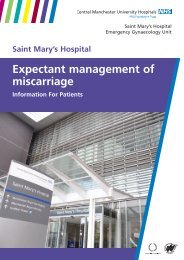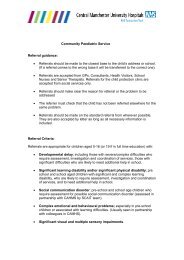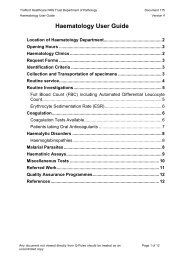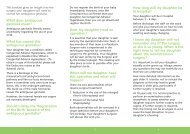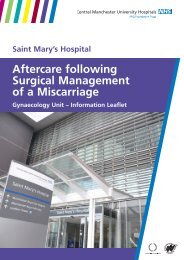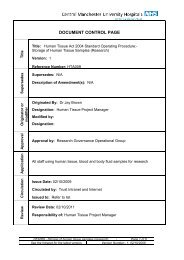08_11388 CM7612 Adult Cochlear - Central Manchester University ...
08_11388 CM7612 Adult Cochlear - Central Manchester University ...
08_11388 CM7612 Adult Cochlear - Central Manchester University ...
You also want an ePaper? Increase the reach of your titles
YUMPU automatically turns print PDFs into web optimized ePapers that Google loves.
Royal <strong>Manchester</strong> Children’s Hospital<br />
A Guide To Having a<br />
Micturating Cystogram<br />
Department of Radiology
This booklet is to help explain about having an Micturating<br />
Cystogram (MCU), also known as a bladder X-ray.<br />
The Doctors involved in your child’s care have requested this<br />
examination as the most appropriate test to help diagnose<br />
your child’s problem.<br />
We hope you find this leaflet helpful in explaining the<br />
procedure. If you have any questions regarding the MCU<br />
X-ray, please ring the department and speak to a member<br />
of staff before your appointment, or feel free to ask on<br />
the day.<br />
What Is An MCU/Bladder X-ray?<br />
An MCU is a special X-ray test to show the bladder and<br />
how it works.<br />
What Should Be Done Before The Test?<br />
There are no special instructions to follow, although your<br />
child can bring a video to watch or a book to read whilst<br />
the X-ray is taking place.<br />
How Long Will The Test Take?<br />
The whole procedure takes about 20 minutes, although<br />
this can vary slightly.<br />
Can I Be With My Child During The Test?<br />
You are more than welcome to be with your child<br />
throughout the test, unless you are pregnant.<br />
3
What Happens During The Test?<br />
1. To begin with you will be asked to undress your child and<br />
they may be asked to put on a gown. This is to make sure<br />
that no buttons or zips from their clothes show on the<br />
X-ray pictures.<br />
2. Your child will need to lie on the X-ray bed throughout<br />
the test. Over the bed is an X-ray camera.<br />
3. To make sure that your child’s bladder shows up on the<br />
X-ray pictures we will need to put some X-ray dye into<br />
their bladder.<br />
4. To get this dye into the bladder, a small, soft tube<br />
needs to be put into the hole where your child passes<br />
urine (wee) from.<br />
This may be a little uncomfortable, but to help we use<br />
a numbing gel.<br />
5. Once the tube is in place we will start to fill the<br />
bladder with dye and X-ray pictures will be taken<br />
as the bladder fills.<br />
6. When your child’s bladder is full they will need to pass<br />
urine. At this stage the tube will gently be removed<br />
and some final X-ray pictures will be taken. This is<br />
done to look at how the bladder is working.<br />
The test is now completed. Your child can get dressed and<br />
can eat and drink as normal.<br />
When Will The Results Be Ready?<br />
All the X-rays are looked at by the Radiologist (a Doctor<br />
who reports X-rays). They will send the results to the Doctor<br />
who arranged the test for you. Your Doctor will explain the<br />
results to you when you attend for your next appointment<br />
with them, or may alternatively write to you.<br />
4
Risks and Benefits<br />
Everyone is exposed to ionising radiation (for example from<br />
gamma rays from space, air travel, natural radiation from the<br />
ground) all the time. This is one of the causes of cancer and<br />
other illnesses. This test will give your child a small extra<br />
dose of ionising radiation. Your Doctors have taken this into<br />
account when asking your child to have this test, and<br />
believe that this the best test for you or your child.<br />
Girls of 12 years and over will be asked to tell us the first<br />
day of their last menstrual period so that we can avoid giving<br />
radiation to an unborn baby unless it is absolutely necessary<br />
for the test to work. This is because the risk is slightly greater<br />
for unborn children.<br />
You can get more information about the risks and benefits of X-<br />
rays from www.nhs.uk or www.hpa.org.uk. Go to the<br />
homepages and search for ‘X-rays’.<br />
Questions<br />
We understand that there may be questions or queries<br />
that either you or your child would like to be answered,<br />
and sometimes you may forget what you want to ask.<br />
The space below has been designed for you to write<br />
down any questions or queries that you may have.<br />
5
No Smoking Policy<br />
The NHS has a responsibility for the nation’s health.<br />
Protect yourself, patients, visitors and staff by adhering to our<br />
no smoking policy. Smoking is not permitted within any of our<br />
hospital buildings or grounds.<br />
The <strong>Manchester</strong> Stop Smoking Service can be contacted on<br />
Tel: 0161 205 5998 (www.stopsmokingmanchester.co.uk).<br />
Translation and Interpretation Service<br />
Do you have difficulty speaking or understanding English?<br />
☎ 0161 276 6202/6342<br />
Department of Radiology<br />
Royal <strong>Manchester</strong> Children’s Hospital<br />
Oxford Road,<br />
<strong>Manchester</strong><br />
M13 9WL<br />
Tel: 0161 701 4000<br />
Monday to Friday 8.30 am to 5.00 pm<br />
www.cmft.nhs.uk<br />
© Copyright to <strong>Central</strong> <strong>Manchester</strong> <strong>University</strong> Hospitals NHS Foundation Trust<br />
TIG 21/10 (SF Taylor CM2578)<br />
Produced January 2006 Updated January 2010 Review Date January 2012




